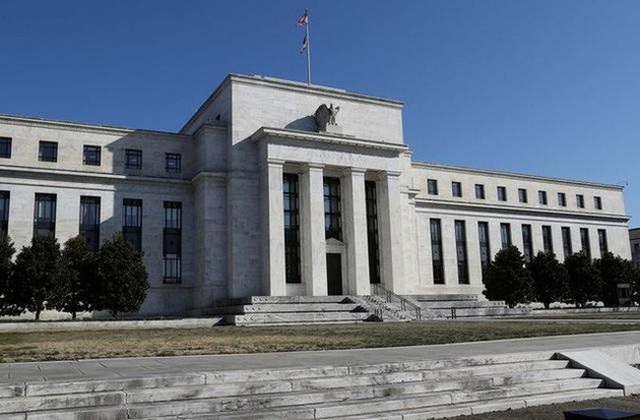The “oil slick” from the US raising interest rates for weaker economies
When the US Federal Reserve (FED) interest rate increaseThe impact of that decision goes beyond just US homebuyers paying more for mortgages, or small, independent business owners facing more expensive bank loans.
Experts emphasized that the impact of the Fed’s decision could extend beyond the US borders, affecting shop owners in Sri Lanka, farmers in Mozambique and families in many poor countries around the world. It could have a range of effects, from driving up borrowing costs in these countries to depreciating their currencies.
The Fed’s calculation
On May 4, the FED raised short-term interest rates by 0.5 percentage points to the highest level since the pandemic occurred two years ago, and signaled that there would be more rate hikes. Currently, the reference interest rate in the US is in the range of 0.75% – 1%.
By pushing up interest rates, the Fed hopes to achieve a “soft landing” scenario – just raising interest rates high enough to slow down activity in the economy and control inflation, but not strong enough to push the economy into a recession.
In March 2022, US consumer prices rose 8.5% from a year earlier – the biggest increase since 1981.
The spike in inflation was the result of an unexpectedly strong recovery from the recession caused by the pandemic in 2020. The rebound was so sudden that businesses were caught by surprise and had to compete fiercely to compete. Looking for workers and sources of supply to meet the needs of customers. As a result, the economy faces shortages, delays in ordering and skyrocketing prices.

The headquarters of the US Federal Reserve (FED) in Washington DC. (Photo: Reuters).
Developing countries worry that the Fed may have waited too long to begin its anti-inflation campaign. As a result, the US central bank will be forced to raise interest rates so sharply that it causes a “hard landing” that hurts both the economy and the developing world.
Liliana Rojas-Suarez, a senior fellow at the Center for Global Development (CGD) nonprofit think tank, said the situation would have been much better if the Fed had reacted more quickly when the problem surfaced last year.
The expert noted that the Fed does not have an impressive track record in navigating policy to achieve “soft landings”. The last time such an effort took place was in the mid-1990s under Fed Chairman Alan Greenspan. This period ended on a negative note for many developing countries.
Rojas-Suarez reiterated that the United States could then manage inflation and avoid a recession, but at the same time create a big impact for emerging markets. Following the Fed’s rate hike was a series of financial crises in Mexico, in Russia and eventually across Asia.
Eric LeCompte, Executive Director of Jubilee USA Network, a coalition to support global poverty alleviation also shared the same view, emphasizing that the Fed’s decision will put pressure on all countries that are struggling. develope.
Impact “oil slick”
The Managing Director of the International Monetary Fund (IMF), Ms. Kristalina Georgieva has expressed great concern about this issue. Last month, she warned the Fed and other central banks to “keep an eye on the spillover risks to vulnerable developing and emerging economies” from the decision to raise interest rates. their.
The U.S. decision to raise interest rates could cause spillover damage in a number of ways. First, they can be the background US economy growth slowed and reduced American consumer demand for foreign goods. This will make countries heavily dependent on exporting goods to the US market suffer a lot
Next, rising interest rates also affect global investment: When interest rates in the US are high, the already safe US government and corporate bonds will appear more attractive to international investors. So they can withdraw capital from the markets of poor and middle-income countries to invest in the US. Those changes boosted the dollar’s value while depreciating local currencies in developing countries.
Currency devaluation can cause many problems. They make it more expensive to pay for imported food and other products. That is especially worrisome at a time when supply chain bottlenecks and the war in Ukraine have disrupted shipments of grain and fertilizer, and pushed food prices around the world to alarmingly high levels.
To protect their currencies, central banks in developing countries have the ability to raise their own rates. But that can do a lot of economic damage: slowing growth, wiping out jobs and making it harder for people to get business loans. That move also forces indebted governments to spend more of their budgets on debt interest payments, while cutting spending on things like fighting the epidemic and ensuring the well-being of the poor.
IMF Director-General Georgieva has warned that 60% of low-income countries are at or near the threshold of “debt exhaustion” – an alarming threshold given the amount of money they pay off their debt. equivalent to half the size of the national economy.
Citing harsher financial conditions, the IMF recently downgraded its 2022 economic growth outlook for developing and emerging market countries to 3.8% – up to one percentage point lower than forecast in January.
However, despite the risks involved, the FED is expected to raise interest rates a few more times this year to combat high inflation in the country.

The response space of developing economies
However, the situation is not so dire for all developing countries. Robin Brooks, chief economist at the Institute of International Finance (IIF), notes that many emerging markets are in much stronger financial shape than they were in the 1990s, or even in 2013. , when the Fed plans to cut loose monetary policies, causing investment flows to flow out of developing market groups.
This is because many countries have boosted their foreign exchange reserves, allowing central banks to use the above to buy and support the national currency or meet foreign debt payments in a single call. crisis. For example, before the 1997-1998 Asian financial crisis, Thailand’s foreign exchange reserves were equivalent to only 19% of the size of this economy. Currently, the above figure of the Southeast Asian country is at 47%.
Brooks also said that rising raw material prices were “a bit of luck” for commodity exporters, such as oil-producing Nigeria and soybean-producing Brazil.
However, many countries are still vulnerable to financial shocks. These include countries that rely heavily on imported oil and other commodities, while having low foreign exchange reserves relative to foreign debt. Topping Rojas-Suarez’s list of countries with the highest financial risk is Sri Lanka, which last month said it had to suspend foreign debt payments while implementing a restructuring program. loan with the IMF. Also “flashing red” are Tunisia, Turkey and Mozambique.
In short, rising US interest rates are not always catastrophic for the developing world. If interest rates rise because of a strong US economy – which means businesses as well as consumers want loans to buy more – countries that export to this market will have more opportunities. .
But the consequences are very different when the Fed raises interest rates in a deliberate campaign to slow growth and push inflationary pressure away from the economy.
“If rate hikes are primarily driven by worries about inflation or a hawkish turn,” economists at the Fed and the American Enterprise Institute wrote in a report last year. In the Fed’s policy, this is likely to cause more turmoil for emerging markets.” The worrying thing is that the Fed is doing just that.
* Invite readers to watch programs broadcast by Vietnam Television on TV Online and VTVGo!
at Blogtuan.info – Source: vtv.vn – Read the original article here



